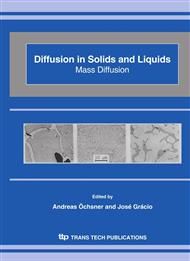[1]
D. Shaw: Atomic Diffusion in Semiconductors (Plenum Press, London and New York 1973).
Google Scholar
[2]
J. Crank: The Mathematics of Diffusion, (Oxford at the Clarendon Press (1956), Chapter: V, VIII, IX, X, XII).
Google Scholar
[3]
G. D. Watkins: Lattice Defects in Semiconductor, Inst. Phys. London, Conf. Ser. 23, (1994).
Google Scholar
[4]
G. D. Watkins, J. R. Troxell and Chatterjee: Vacancies and interstitial in silicon, Inst. Phys. Conf. Ser. No 46 Chatter I (1978), p.16.
Google Scholar
[5]
A. Seeger and K. P. Chik: Phys. Stat. Sol. 29 (1968), p.455.
Google Scholar
[6]
H. Mehrer: Diffusion and Ionic Transport in Borate Glasses, Proceeding of DIMAT (2004).
Google Scholar
[7]
U. Gosele, and T. Y. Tan: The influence of point defects on diffusion and gettering in Silicon, Impurity Diffusion and Gettering in Silicon. Ed. By R. B. Fair, B.B. Pearce, C.W.; Washburn, J. MRS. Pittsburgh, Pennsylvania (1985).
DOI: 10.1557/proc-36-105
Google Scholar
[8]
U. Gösele and T.Y. Tan: Defects in Semiconductor II, New York (1983), p.153.
Google Scholar
[9]
R. B. Fair: Diffusion and Defect Data Vol. 37 (1984), p.1.
Google Scholar
[10]
R. Fair: Impurity Doping Processes in Silicon, New York (1981), p.315.
Google Scholar
[11]
S. Matsumoto, E. Arai, H. Nakamura, and T. Niimi: Japanese J. Appl. Phys. Vol. 16 (1977), p.1177.
Google Scholar
[12]
S. M. Hu and Schmidt: J. Appl. Phys. Vol. 39 (1968), p.320.
Google Scholar
[13]
S. Miszuon, H. Higuchi (1985), Investigation of point defects in Si by impurity diffusion, Impurity Diffusion and gettering in silicon, Materials Research Society Symposia Proceeding, vol. 36, Pittsburgh, Pennslvania, USA, p.125.
Google Scholar
[14]
M. Yoshida: J. Appl. Phys. Vol. 48(6) (1977), p.2169.
Google Scholar
[15]
D. Mathiot, and J.C. Pfister: Appl. Phys. Lett. 48 (1986), p.627.
Google Scholar
[16]
D. Mathiot and J.C. Pfister: Diffusion Mechanisms and Non-equilibrium Defects in Si, Materials Research Society Symposia, USA (1985), p.117.
Google Scholar
[17]
I.V. Belova and G.E. Murch: An Analysis of the Effective Diffusivity in Three- Phase Composite Material Consisting of the Host and Coated Inclusions, Proceeding of DIMAT 2004, p.32.
DOI: 10.4028/www.scientific.net/ddf.237-240.384
Google Scholar
[18]
R. E Howard and A.B. Lidiard: Matter transport in solids, Reports on progress in Physics, 27, 160, (1964).
Google Scholar
[19]
Y. Mishin: Atomistic Modelling of Diffusion in Materials, Proceeding of DIMAT (2004).
Google Scholar
[20]
S.R. De Groot: Thermodynamics of irreversible processes; North - Holland Publishing Company Amsterdam, Fifth Reprint of the First Edition (1963).
Google Scholar
[21]
L. Bernard: Thermodynamics of irreversible processes, London-Basingstoke-Mchillan (1978).
Google Scholar
[22]
Dao Khac An: Application of the Thermodynamics of Irreversible Processes for the Simultaneous Diffusion of Boron, Arsenic and point Defects in Silicon Material. Hungary Academy of KFKI-1990-28/E, Central Research Institute for Physics. Budapest (1990).
Google Scholar
[23]
D. K. An and V. B. Dung: Preliminary Results of Numerical Profiles for the Simultaneous Diffusion of Boron and Point Defects in Silicon using Irreversible Thermodynamic Theory, Diffusion in Materials, Part 1, Editors Y. Limoge and J.L. Bocquet, Scitec Publication Ltd, Switzerland, (2001).
DOI: 10.4028/www.scientific.net/ddf.194-199.647
Google Scholar
[24]
D.K. An, S. Barna, K. Madl, G. Battistig, J. Gyulai: Phys. Stat. Sol. (a) Vol. 118 (1989), p.95.
Google Scholar
[25]
Dao Khac An: Proceeding of the NCST of Vietnam, Vol. 9 (1997), p.135.
Google Scholar
[26]
Dao Khac An, Le Hoang Mai and Pham Hoi, concentration dependence of the boron diffusion coefficient in Silicon; Phys. Stat.
Google Scholar
[27]
K. Nishi: Process modelling and simulation, Oki Electric Industry Co, Ltd, Proceedings of VLSI technology short course on TCAD an evolution change of the ULSI design and fabrication trend, Kyoto (1997).
Google Scholar
[28]
Dao Khac An: Computer Calculations of Enhanced Diffusivity and Effective Activation Energy from Measured Profiles of Impurities in Silicon, Diffusion in Material, Part 1, Editors Y. Limoge and J.L. Bocquet; Scitec Publication Ltd, Switzerland (2001).
Google Scholar


